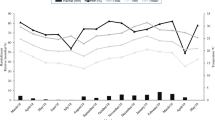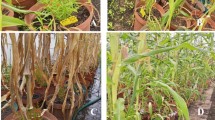Abstract
The corn leafhopper Dalbulus maidis (DeLong & Wolcott) (Hemiptera: Cicadellidae) poses a serious threat to the crop, causing direct and indirect damage to plants. The present study aimed to investigate the possible expression of resistance by antixenosis and/or antibiosis against D. maidis in 11 corn genotypes [8 non-Bt (60XB14, 90XB06, XB 9003, XB 8018, XB 8010, IAC 8390, IAC 8046, and IAC AIRAN) and 3 Bt (XB 7116 Bt, XB 8010 Bt, and DKB 310 Bt)] previously selected in a greenhouse. Initially, no choice preference tests for oviposition were performed to characterize the expression of antixenosis. To characterize the expression of antibiosis/antixenosis, the insects were confined to leaves of different genotypes to assess the following parameters: duration of each nymphal stage, nymphal period, viability per instar, total viability, and adult longevity. Additionally, morphological and physical analyses of the genotypes were carried out to establish correlations with the resistance categories. The genotypes 90XB06, IAC 8390, XB 9003 and DKB 310 PRO3 expressed antixenosis against leafhoppers, reducing insect oviposition. The genotypes 60XB14, 90XB06, IAC 8046, XB 8018 and IAC 8390 expressed antibiosis and/or antixenosis against leafhoppers, reducing nymphal viability. The hardness of the ribs is probably associated with the resistance of some of the evaluated genotypes and is an important morphological defense against leafhoppers. The results of this study are novel and can aid in corn-breeding programs focused on plant resistance to sucking insects, with relevant impacts on the integrated pest management of the crop.




Similar content being viewed by others
References
Arora R, Sandhu S (2017) Insect-plant interrelationships. In: Arora R, Sandhu S (eds) Breeding insect resistant crops for sustainable agriculture. Springer, Singapore, pp 1–44. https://doi.org/10.1007/978-981-10-6056-4
Baldin ELL, Cruz PL, Morando R, Silva IF, Bentivenha JPF, Tozin LRS, Rodrigues TM (2016) Evaluating categories of resistance in soybean genotypes from the United States and Brazil to Aphis glycines (Hemiptera: Aphididae). Fla Entomol 99:487–495
Baldin ELL, Vendramim JD, Lourenção AL (2019) Resistência de plantas a insetos: fundamentos e aplicações. Fealq, Piracicaba
Bellota E, Medina RF, Bernal JS (2013) Physical leaf defenses—altered by Zea life-history evolution, domestication, and breeding—mediate oviposition preference of a specialist leafhopper. Entomol Exp Appl 149:185–195. https://doi.org/10.1111/eea.12122
Bueno NM, Baldin ELL, Canassa VF, do Prado Ribeiro L, da Silva IF, Lourenção AL, Koch RL (2020) Characterization of antixenosis and antibiosis of corn genotypes to Dichelops melacanthus Dallas (Hemiptera: Pentatomidae). Gesunde Pflanz. https://doi.org/10.1007/s10343-020-00529-z
Burtet LM, Bernardi O, Melo AA, Pes MP, Strahl TT, Guedes JVC (2017) Managing fall armyworm, (Lepidoptera: Noctuidae), with Bt maize and insecticides in southern Brazil. Pest Manag Sci 73(12):2569–2577
Catarino R, Ceddia G, Areal F, Parisey N, Park J (2016) Managing maize under pest species competition: is Bt (Bacillus thuringiensis) maize the solution? Ecosphere 7(6):e01340
Collins HL, Pitre HN (1969) Corn stunt vector leafhopper attractancy to and oviposition preference for hybrid dent corn. Ann Entomol Soc Am 62:773–775. https://doi.org/10.1093/aesa/62.4.770
Conab (2019) Acompanhamento da safra brasileira de grãos, safra 2019/20—Primeiro levantamento, Brasília. http://www.conab.gov.br. Accessed 13 Nov 2019
Cruz I (2012) Manejo de Pragas não Alvo de Milho Bt Incidentes na parte aérea da planta. In: Paterniani M, Duarte AP, Tsunechiro A (eds) Diversidade e inovações na cadeia produtiva de milho e sorgo na era dos transgênicos. ABMS/IAC, Campinas, pp 321–340
Glas JJ, Schimmel BC, Alba JM, Escobar-Bravo R, Schuurink RC, Kant MR (2012) Plant glandular trichomes as targets for breeding or engineering of resistance to herbivores. Int J Mol Sci 13:17077–17103. https://doi.org/10.3390/ijms131217077
Hu Q, Zhao J, Cui D (1993) Relationship between content of secondary catabolite-lignin-in soybean and soybean resistance to the soybean aphid. Plant Prot 19:8–9
ISAAA (2017) International service for the acquisition of agri-biotech Applications. Global status of commercialized biotech/GM crops in 2017: biotech crop adoption surges as economic benefits accumulate in 22 years. Ithaca
Lara FM (1991) Princípios de resistência de plantas a insetos. Ícone, São Paulo
Lopes JRS, Oliveira CM (2004) Vetores de vírus e molicutes em milho em milho. In: Oliveira E, Oliveira CM (eds) Doenças em milho: molicutes, vírus, vetores, mancha por Phaeosphaeria. Embrapa Milho e Sorgo, Sete Lagoas, pp 35–60
Loy DD, Lundy EL (2019) Nutritional properties and feeding value of corn and its coproducts, 3rd edn. Elsevier Inc, Amsterdam, pp 633–659. https://doi.org/10.1016/B978-0-12-811971-6.00023-1
Malavolta E (2006) Manual de nutrição mineral de plantas. Agronômica Ceres, Ouro Fino
Marín L et al (1987) Biologia y comportamiento de Dalbulus maidis (Homoptera: Cicadellidae). Rev Peru Entomol 30:113–117
Minitab I (2010) Minitab minitab 16 statistical software PA minitab, Inc, State Coll. www.minitab.com. Accessed 10 Oct 2019
Nault LR (1980) Maize bushy stunt and corn stunt: a comparison of disease symptoms, pathogen host ranges, and vectors. Phytopathology 70:659–662. https://doi.org/10.1094/Phyto-70-659
Oliveira E, Magalhães PC, Gomide RL, Vasconcelos CA, Souza IRP, Oliveira CM, Cruz I, Schaffert RE (2002) Growth and nutrition of mollicute-infected maize. Plant Dis 86:945–949. https://doi.org/10.1094/PDIS.2002.86.9.945
Oliveira E, Oliveira CM, Magalhães PC, AndradeCLT, Hogenhout SA (2005) Spiroplasma and phytoplasma infection reduce kernel production and nutrient and water contents of several but not all maize cultivars [Zea mays L.]. Maydica, Italy. http://agris.fao.org/agris-search/search.do?recordID=IT2006601811. Accessed 16 Aug 2019
Oliveira CM, Oliveira E, Canuto M, Cruz I (2007) Controle químico da cigarrinha-do-milho e incidência dos enfezamentos causados por molicutes. Pesqui Agropecu Bras 42:297–303. https://doi.org/10.1590/S0100-204X2007000300001
Oliveira CM, Lopes JRS, Nault LR (2013) Survival strategies of Dalbulus maidis during maize off-season in Brazil. Entomol Exp Appl 147:141–153. https://doi.org/10.1111/eea.12059
Painter RH (1951) Insect resistance in crop plants. McMillan, New York
Panda N, Khush GS (1995) Host plant resistance to insects. CAB International International Rice Research Institute, Wallingford
Ritchie WS, Benson GO, Lupkes S, Salvador RJ, Ritchie SW, Ritchie BW, Salvador R (1993) How a corn plant develops. Iowa State University. Special report n. 48, Ames. www.maize.agron.iastate.edu/corngrows.html. Accessed 09 Aug 2019
Silva JP, Baldin EL, Canassa VF, Souza ES, Lourenção AL (2014) Assessing antixenosis of soybean entries against Piezodorus guildinii (Hemiptera: Pentatomidae). Arthr Plant Inter 8:349–359. https://doi.org/10.1007/s11829-014-9316-1
Smith CM (2005) Plant resistance to arthropods: molecular and conventional approaches. Springer, New York
Tsai JH (1988) Bionomics of Dalbulus Maidis (DeLong and Wolcott), a vector of mollicutes and virus (Homoptera: Cicadellidae). In: Maramorosch K, Raychaudhuri SP (eds) Mycoplasma diseases of crops: basic and applied aspects. Springer, New York, pp 209–221. https://doi.org/10.1007/978-1-4612-3808-9_12
Veljković VB, Biberdžić MO, Banković-Ilić IB, Djalović IG, Tasić MB, Nježić ZB, Stamenković OS (2018) Biodiesel production from corn oil: a review. Renew Sustain Energy Rev 91:531–548. https://doi.org/10.1016/j.rser.2018.04.024
Virla EG, Moya-Raygoza G, Luft-Albarracin E, Ni X (2013) Egg parasitoids of the corn leafhopper, Dalbulus maidis, in the southernmost area of its distribution range. J Insect Sci 13:1–7. https://doi.org/10.1673/031.013.1001
Waquil JM (1998) Corn leafhoppers as vectors of maize pathogens in Brazil. Diagnosing maize diseases in Latin America. ISAAA, Ithaca/EMBRAPA, Brasilia, 34–42. http://www.isaaa.org/Resources/publications/briefs/09/download/isaaa-brief-09-1998.pdf#page=44. Accessed 17 May 2019
Waquil JM, Viana PA, Cruz I, Santos JP (1999) Aspectos da biologia da cigarrinha-do-milho, Dalbulus maidis (DeLong & Wolcott) (Hemiptera: Cicadellidae). An da Soc Entomol Bras 28:413–420. https://doi.org/10.1590/S0301-80591999000300005
Weber D, Egan PA, Muola A, Ericson LE, Stenberg JA (2020) Plant resistance does not compromise parasitoid-based biocontrol of a strawberry pest. Sci Rep 10:1–10. https://doi.org/10.1038/s41598-020-62698-1
Zurita VYA, Anjos N, Waquil JM (2000) Aspectos biológicos de Dalbulus maidis (DeLong & Wolcott) (Hemiptera: Cicadellidae) em híbridos de milho (Zea mays L.). An da Soc Entomol Bras 29:347–352. https://doi.org/10.1590/S0301-80592000000200017
Acknowledgements
We thank the Conselho Nacional de Desenvolvimento Científico e Tecnológico (CNPq) for granting a scholarship to the first author of the present work and for granting a research productivity Grant (no. 305649/2013-2) to the second author and to the Coordenação de Aperfeiçoamento de Pessoal de Nível Superior—Brazil (CAPES)—Financing Code 001.
Author information
Authors and Affiliations
Corresponding author
Additional information
Handling Editor: Joe Louis.
Publisher's Note
Springer Nature remains neutral with regard to jurisdictional claims in published maps and institutional affiliations.
Rights and permissions
About this article
Cite this article
Faria, R.D., Baldin, E.L.L., Takaku, V.S. et al. Variable levels of antibiosis and/or antixenosis of Bt and non-Bt maize genotypes on Dalbulus maidis (Hemiptera: Cicadellidae). Arthropod-Plant Interactions 15, 457–465 (2021). https://doi.org/10.1007/s11829-021-09832-6
Received:
Accepted:
Published:
Issue Date:
DOI: https://doi.org/10.1007/s11829-021-09832-6




